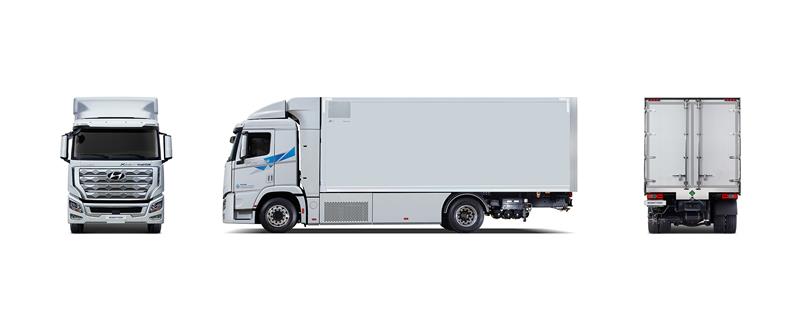The company plans to ship a total of 50 Xcient Fuel Cells to Switzerland this year, with handover to commercial fleet customers starting in September. Hyundai plans to roll out a total of 1,600 Xcient Fuel Cell trucks by 2025, reflecting the company’s environmental commitment and technological prowess as it works toward reducing carbon emissions through zero-emission solutions.
Hyundai Motor executive vice president and head of the commercial vehicle division In Cheol Lee says: “Building a comprehensive hydrogen ecosystem, where critical transportation needs are met by vehicles like Xcient Fuel Cell, will lead to a paradigm shift that removes automobile emissions from the environmental equation.”
The launch follows what it calls the world’s first mass-produced fuel-cell electric passenger vehicle, the ix35, and the second-generation fuel cell electric vehicle, the NEXO.
The 4x2 rigid is powered by a 255bhp hydrogen fuel cell system with dual 95kW fuel cell stacks. Seven hydrogen tanks offer a combined storage capacity of around 32.09kg of hydrogen. The driving range for Xcient Fuel Cell is about 400 km on a single refuelling in the refrigerated upfit configuration while operating 34-tonne truck + trailer combination. That particular range was developed to balance the specific requirements from the potential commercial fleet customers and the charging infrastructure in Switzerland. Refuelling time for each truck takes approximately 8-20 minutes.
In addition to Xcient Fuel Cell, Hyundai Motor says it is developing a long-distance tractor unit capable of traveling 1,000km on a single charge.
In 2019, Hyundai Motor Company formed Hyundai Hydrogen Mobility (HHM), a joint venture with Swiss company H2 Energy, which will lease the trucks to commercial truck operators on a pay-per-use basis, meaning there is no initial investment for the commercial fleet customers.
Hyundai chose Switzerland as the starting point for its business venture for various reasons. One of the reasons is the Swiss LSVA road tax on commercial vehicles does not apply for zero-emission trucks. That nearly equalizes the hauling costs per kilometre of the fuel cell truck compared to a regular diesel truck.
Hyundai’s business case involves using purely clean hydrogen generated from hydropower. To truly reduce carbon emissions, all of the trucks need to run on only green hydrogen. Switzerland is the country with one of the highest shares of hydropower globally, and can therefore deliver sufficient green energy for the production of hydrogen. Once the project is underway in Switzerland, Hyundai plans to expand it to other European countries as well.
By using hydrogen-powered vehicles in commercial transportation, Hyundai ensures a steady demand for hydrogen fuel. And by producing industrial hydrogen, Swiss firm Hydrospider ensures a steady supply. Through this process, Hyundai says it will gradually build up a hydrogen infrastructure in Switzerland.
The set-up of the truck-refuelling infrastructure in Switzerland with stations running with 350 bar opens up the chance to extend the network as well for fuel cell passenger cars, which are refuelled at double that pressure.

Specifications
| Item Model | | XCIENT Fuel Cell |
| Vehicle Type | | Cargo (Chassis Cab) |
| Cab Type | | Day Cab |
| Drive System | | LHD / 4X2 |
| Dimensions [mm] | |
| Wheel Base | | 5,130 |
| Overall (Chassis Cab) | |
| | Length | 9,745 |
| | Width | 2,515 (2,550 with side protector), Maximum allowable width 2,600 |
| | Height | 3,730 |
| Weight [kg] | | |
| Max. Gross Combination Weight | 36,000 as pull-cargo |
| Max. Gross Vehicle Weight | 19,000 as rigid truck |
| | Front / Rear | 8,000 / 11,500 |
| Empty Vehicle Weight (Chassis Cab) | 9,795 |
| Calculated Performance | |
| Drive Range | | Accurate range to be confirmed |
| Max. Speed | | 85km/h |
| Powertrain | | |
| Fuel Cell Stack | 190 kW (95 kW x 2 EA) |
| Battery | | 661 V / 73.2 kWh – by Akasol |
| Motor / Inverter | 350 kW / 3,400 Nm – by Siemens |
| Transmission | | ATM S4500 – by Allison / 6 forward speeds and 1 reverse speed |
| Rear Axle ratio | 4.875 |
| Hydrogen Tank | |
| Filling Pressure | 350 bar |
| Capacity | | 32.09 kg H2 (available hydrogen amount at SOF 100%) |
| Brakes | | |
| Service Brake | Disc |
| Auxiliary Brake | Retarder (4-Speed) |
| Suspension | | |
| Type | Front / Rear | Air (2-bag) / Air (4-bag) |
| Tyres | Front / Rear | 315/70R22.5 / 315/70R22.5 |
| Safety | | |
| Front Collision-avoidance Assist (FCA) | Standard |
| Smart Cruise Control (SCC) | Standard |
| Electronic Braking System (EBS) + Vehicle Dynamic Control (VDC) | Standard (ABS is included in VDC) |
| Lane Departure Warning (LDW) | Standard |
| Air Bag | | Option |